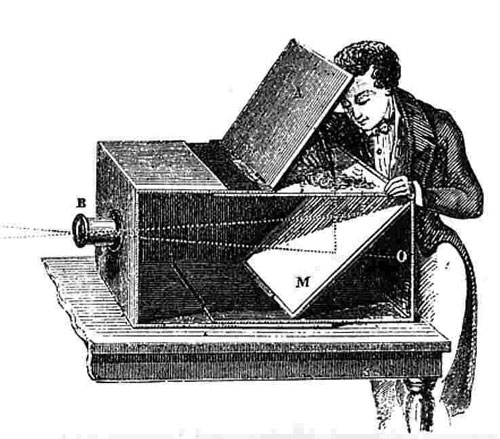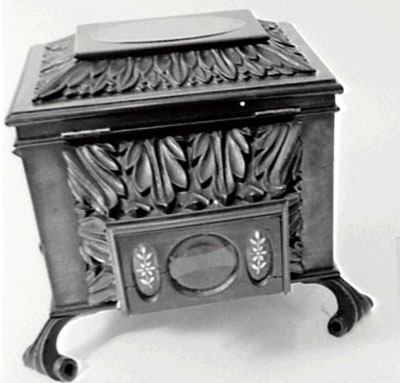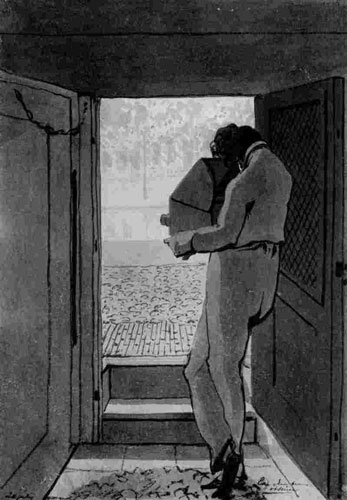The Camera Obscura and Photographic Vision
1987 paper by Gael Newton AM - with February 2022 notes
A slightly editted version of text originally drafted in 1987, but not published.
additional notes (February 2022)
This was written in 1987 to get the sequence of development of photographic vision sorted in my head for my ‘Shades of Light’ exhibition and book. I had planned to have a section on Australian camera obscura or camera lucida use but I did not find actual drawings made with the device to warrant including the topic.
There were a number of camera obscura platforms built in homes in Australia. Sydney artist John Rae used a portable camera obscura in the 1840s and had one built atop his houseHilton, in Liverpool Street, Darlinghurst in 1854.
A number of contemporary artists however use the camera obscura most notably Robyn Stacey for room installations and Doug Spowart and Victoria Cooper converted their campervan to acts a camera obscura. Various workshops in pin hole camera construction and use have been run.
Martyn Jolly has a blog on Camera Obscura with pictures of Australian examples. https://martynjolly.com/tag/camera-obscuras/
 |
 |
#1. A Camera obscura box with mirror, with an upright image at the top
Wikipedia By unknown illustrator - 19th Century Dictionary Illustration,
Public Domain |
#2. Camera obscura with components from France
Museum of Applied Arts & Sciences, accessed 2 February 2022 |
The Camera Obscura and Photographic Vision
(paper drafted in 1987)
The basis of photography is in naturally occurring phenomena in the behaviour of light. Objects in the path of a light source cast shadow-images which preserve their outlines, yet vary in size and sharpness if the object or light source is moved. Skin tanned by the sun also retains the pattern of clothes or bracelets; shiny surfaces and sheets of water tantalise us with mirror and inverted images.
These simple phenomena are the original, magic and evocative sun pictures. Unlike Narcissus from Greek mythology, who was transfixed by his own reflection, ancient philosophers sought answers as to why some surfaces created sun pictures and others not, and posed questions about vision.
The most dramatic sun pictures arise when light rays, passing through small holes intersect to form upside-down images of natural objects on plane surfaces such as walls and floors. This effect can be seen outdoors as when tiny holes in foliage cast their images on the ground but is best seen inside a dark room with a hole in the outside wall or roof.
The author's own bedroom blind has a small, quite jagged tear which still casts an effective image of the trees outside on the wall. One Australian photographer's career began with the sight of such an image inside the backyard dunny (toilet).
The Greek philosopher Aristotle (384-322BC) reputedly viewed a partial eclipse of the sun safely in his way, though he believed light actually emanated from the eye of the beholder.
The Latin terms for dark room 'camera obscura’ came to be the generic term for the effect and also for the portable versions developed from the late 16th century onwards up unto the present day. Small box camera obscuras were modified for use in the early 19th century by experimenters with photographic processes and the term camera came to distinguish the new models.
Whilst the camera obscura was observed by the Greeks in the 6th century and the Chinese in the fourth, the Arabian scholars in the tenth century described and explained the phenomenon. Islamic mathematician and physicist, known as Alhazen in the west, wrote an influential text on topics in relation to later European science and culture.
Alhazen's Opticae Thesaurus Alhazeni was written in 1000AD and explained the camera obscura effect in terms of a cone of rays. Light rays are reflected from the object into the eye in the same way as they pass through the aperture of the camera obscura.
The closer the object to the aperture, the larger the corresponding image on the wall or retina. Perspective science depends on understanding the cone of vision.
The principles of the camera obscura were widely known in the 13th and 14th centuries but the applications were confined to illustration of optical science or for observation of eclipses in which connection the first known illustration of the camera obscura was published in 1544.
By the mid 16th century a biconvex lens appears to have been inserted into the apertures of camera obscura and by the close of the century portable versions in the form of tent or box-like structures had appeared.Lens manufacture began to develop at the close of the 13th century, when eye-glasses appeared. The humble spectacles (first made with semi-precious stone, then glass) extended the working life of scholars and artisans and became even more valuable after about 1440 when Johann Gutenberg's printing press signalled the rise of new era in communication of word and image.
The magnification achieved by effect of aligning two spectacle lenses (concave for the old and convex for the shortsighted) must have been well known to the makers but it was not till the Renaissance period in the late 16th century that ‘perspective glasses’ as telescopes were called, and microscopes were developed.
The Mediaeval world was steeped in religious faiths and not so interested in the physical world or how things looked. However, a new breed of natural philosophers, as they came to be called, believed in observation, evidence and experimentation. One of this generation was Galileo Galilei (1564-1642), Professor of Mathematics at Padua. When he heard of a Flemish spy-glass around June of 1609, he realised its marvellous effects 'must be founded on the science of perspective'. Subsequently he constructed a spy-glass of his own design with considerably higher powers of magnification and demonstrated it to the Signoria of Venice.
The governors, merchants and brokers of Venice, then the most powerful wealthy port in Europe, were more interested in using the telescope to find out which war ships or trading vessels were approaching Venice. We know from Shakespeare's play The Merchant of Venice what fortunes could await news that one's ship had come in.
Galileo turned his telescope on the heavens and became one of the first to see the moon clearly enough to map its craters and prove that it was not the smooth perfect sphere of classical astronomy. In an amazingly short time Galileo had accumulated enough information using the telescope to publish The Starry Messenger in March 1610.
By showing that there were even extra planets (satellites of Jupiter) than in the Ptolemaic universe sanctioned by the Papal authorities, Galileo hoped to support the theories of Nicolaus Copernicus (1473-1543) that the sun was the centre of the universe and that the planets all moved around it.
Copernicus had published his book The Revolution of the Heavenly Orbs on his deathbed in 1543. The term 'revolutionary' derives from the impact the heliocentric theory of planetary motion had on science and philosophy, and cosmology. The heavens were believed to be made up of seven perfect spheres fixed in position around the earth. The notion that a divine order could be upset simply by 'looking' through a device was profoundly at odds with a religious society in which the senses and anything earthly and temporal were seen as ephemeral and unreliable as sources of intellectual or spiritual Truth.
Copernicus' book was banned until 1758 and Galileo was charged with heresy after publishing his proof of the Copernican theory in his Dialogue on the Great World Systems in 1632.
Galileo was not the only scientist to be inspired by the telescope. Johannes Kepler (1571-1630) used it and went on to work out the theory of such refracted light instruments in his Dioptrice of 1611.
Both Copernicus and Galileo also used the microscope which seems to predate the telescope slightly appearing regularly from the late 16th century. Microscopic vision was equally revolutionary in showing what lay beyond the capabilities of human vision. Robert Hooke (1635-1703) in England began the science of insect anatomy in the 17th century and Antoni Van Leeuwenhoek (1632-1723) a Dutchman made simple lens microscope that were not bettered for a century and demolished the theory of spontaneous generation of life by revealing the existence of bacteria.
Kepler and Hooke used camera obscura apparatus modified for topographical drawing. Kepler had a tented version inside of which he sat, and Hooke illustrated a conical shaped version (1694).
Neapolitan scientist and science populariser Giovanni Battista della Porta (1535–1615) was the first to particularly recommend the camera obscura as a drawing aid to provide details of manipulating it to give an upright image in sharp focus by the use of lenses and mirrors. Porta's suggestions were spread through Europe through the many editions and translations of his Magiae naturalis, a kind of encyclopaedia of its day, which first appeared in parts in 1558.
Porta said that 'If you cannot paint, you can by this arrangement draw’ and in the mid 16th century making pictures was of increasing interest to a wider range of people than ever before.
Scientific perspective, the means of drawing the view from any chosen observer's position, with correct spatial diminution, predates the application of the camera obscura to drawing by two centuries. Yet the image drawn over a camera obscura projection is automatically rendered in correct perspective.
Vision in depiction and truth to appearances had been evolving as a standard since the early 15th century when Leon Battista Alberti (1404-1472) published his Delia Pittura [Of Painting ] in 1435. This was the first treatise for artists and was concerned 'solely with what can be seen'. It showed how to draw in linear perspective from a single vanishing point.
The principle of the cone of rays which Alhazen had used to express the camera obscura became Alberti's presentation of perspective as a visual pyramid the apex of which is the eye of a single observer, fixed in time and space and the base of which is the field of view to be represented.
Whilst not superior to art works in which multiple views of the same object or stages of an event were shown as in the preceding Medieval period, the scientific perspective of the Renaissance aptly fitted the humanism and secularisation of culture of the period by providing a human eye view of nature.
Alberti does not appear to have used the camera obscura it has been argued though he could have arrived at his theories by tracing its images. However, as Porta astutely pointed out the apparatus could assist poor draughtsmen to achieve correct perspective.
During the 17th and 18th centuries use of the camera obscura seems to have been on the ascendant and to have reached a peak in the decades immediately preceding the birth of fixed images. By the 18th century the mobile versions could be at least as compact and flexible as 19th century cameras proper. It was this mobility of viewpoint so clearly suggested by the casual stance of the artist shown using one in 1810 that must have appealed in an age in which was increasingly interested in pictures of everything from all over the world.
When we look at the artist shown by Andriessen with his camera obscura looking for all like the familiar figure of the photographer in the late 19th century, we can only wonder what subliminal impact this mobile obscura had an impact perhaps comparable to the pictorial possibilities opened up in the 1920s and 30s by the hand-held miniature camera the Leica?
There was an increased 'sensitivity' to pictorial possibilities in the 18th and early 19th century which has been attributed to several factors. The population in Europe boomed from two to four hundred million between 1800-1900. The middleclass also expanded in proportion becoming a significant market with taste for realism and pictorial entertainment.
The window-box perspective of the Renaissance was based on a single observer's viewpoint. It was a representation of a given position in space but also in time. "The perspectival painter ... makes us step away from any absolute and abstract view. Not so much a place as a moment is fixed for us, and a fleeting moment: a point of view in time more than in space .... Perspective is not one point of view for the painter it is an active and continuous operation."
The reasons why photography became 'historically imperative' in the late 18th century is a matter of cultural and social analysis not scientific proof. However, the continued use of the camera obscura accelerating as it did after the introduction of window box perspective, may have acted to suggest pictorial possibilities more readily than scientific perspective per se. |
|
 |
| |
#5 Young man with camera obscura,
Jurriaan Andriessen 1810-1819, pen, brown wash, on paper, 25.8 × 18 cm Amsterdam, Rijksmuseum, Rijksprentenkabinet |
The photograph when it did arrive in the 1840s allowed for the close examination of first minutes and finally moments in time. It was a destiny almost predicted by the choice of a one-point perspective window box space in the Renaissance (as an alternative a two-point panoramic format could have been chosen instead).
The widening social base of European society after the French Revolution may well be the catalyst for the emergence of photography as a communication system which could reach large numbers of people across the world. Lithography also developed in the late 18th century and seemed to be set to inherit the role of purveyor of images to the new world of the 19th century but this role would be ultimately taken over by photography.
Supportive of this view of the mass culture influence on the growth of photography is the birth of the other components of modern media at around the same time. The electric telegraph which could lead to radio and television. This was grounded in research into light behaviour and electromagnetisms but similarly arrived in a time of developing need for a new technology.
There were many forerunners who were simply ahead of their times or failed to develop a product For the soil for new knowledge is prepared by the concentration of all forces that make an invention historically imperative, that allows us to recognise a personal achievement as a super personal occurrence and the inventor himself as the instrument of an individual will soon to be that of the community.
It is in the physical (scientific) knowledge acquired in the 18th century and in the new social order prepared for mankind by the French Revolution that we must look for causes of the recast in the aesthetic notions and ideals of the social class that was to determine the coming century. New forms of life are struggling for expression and find new means for doing so.
The history of the camera obscura did not finish with the New Year of 1839. It retained certain graphic arts uses and topographical uses and as a quick means of enlarging and reducing artwork.
Large scale fixed camera obscuras were built as entertainments both privately as in the case of arctic explorer Sir James Ross who had one built at his house in 1829 and such public ones as the still standing at Edinburgh lookout. Artist John Rae in Sydney in the 1850s had one built atop his Darlinghurst house.
The reduced pictures of these views, which are both moving and in natural colours, fascinate contemporary audiences despite the existence of cinemas.
Public Panorama entertainments which showed gigantic painted views inside specially constructed buildings also developed in the late 18th century and were somewhat related to public camera obscuras. The viewer was surrounded by the views and either moved around them or watched a scroll of images being unwound.
The Diorama invented by J.L.M. Daguerre and shown in Paris and London in 1820s added atmosphere through lighting effects. Daguerre used the camera obscura as an aid and the fixing of its images became an obsession. Perhaps he sought film rather than photography though none had even dreamed of such a thing.
As master of the diorama Daguerre was well aware of the public taste and may have intuitively realised the role such a thing as photography might have with the public. Ultimately Daguerre's photography would be given to the world in 1839 - a means for every man to have a bit of the world as promised by Renaissance window box perspective.
more of Gael Newton's Essays and Articles
|